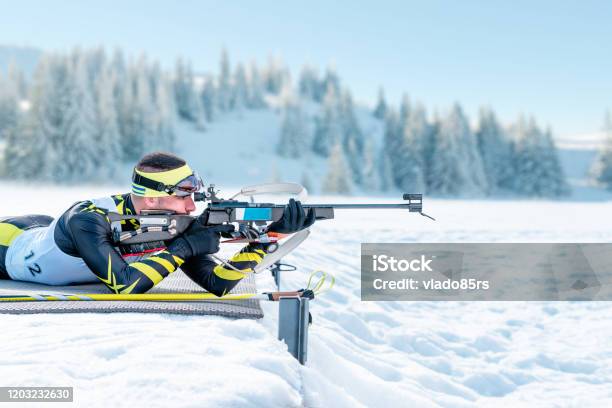Biathlon: The Fusion of Precision and Endurance
In the frigid landscapes of winter sports, one discipline stands out for its unique blend of cardiovascular prowess and marksmanship. Biathlon, a captivating Olympic event, challenges athletes to excel in cross-country skiing and rifle shooting. This demanding sport traces its roots to ancient hunting practices and military training, evolving into a thrilling spectacle that tests both physical and mental limits.

The Origins of Biathlon
Biathlon’s history is as rich and varied as the landscapes it inhabits. The sport’s earliest incarnations can be traced back to prehistoric times when hunting on skis was a necessity for survival in snow-covered regions. Ancient rock carvings in Norway depict hunters on skis, armed with bows and arrows, pursuing prey across frozen tundras.
As civilizations advanced, the combination of skiing and shooting evolved into a military skill. Scandinavian countries, particularly Norway, incorporated ski warfare into their military strategies as early as the 18th century. These “ski troops” were adept at traversing snowy terrain and engaging in combat, laying the groundwork for what would become modern biathlon.
The transition from military application to sport began in the late 19th century. The first known biathlon competition took place in 1767 between Norwegian and Swedish border patrol units. However, it wasn’t until the early 20th century that biathlon started to gain recognition as a formal sport.
The Olympic Journey
Biathlon’s path to becoming an Olympic sport was not without its challenges. The sport made its debut as a demonstration event at the 1924 Winter Olympics in Chamonix, France. However, it was then called “Military Patrol” and was considered a team event. Despite its initial inclusion, biathlon struggled to gain widespread acceptance and was absent from several subsequent Olympic Games.
The breakthrough came in 1960 when biathlon was officially included in the Winter Olympics program in Squaw Valley, California. Initially, only men competed in the individual event. Women’s biathlon was not introduced to the Olympics until 1992 in Albertville, France, marking a significant milestone in the sport’s history and gender equality.
Since its official Olympic debut, biathlon has undergone numerous changes and expansions. New events have been added, including sprint, pursuit, mass start, and relay competitions. These additions have not only increased the sport’s appeal to spectators but have also created more opportunities for athletes to showcase their skills across various formats.
The Technical Aspects of Biathlon
At its core, biathlon is a test of endurance and precision. The sport combines cross-country skiing, which demands exceptional cardiovascular fitness and technique, with rifle shooting, requiring steady hands, keen eyesight, and unwavering focus.
Cross-Country Skiing
The skiing portion of biathlon typically involves the free technique, also known as skate skiing. This style allows for greater speed compared to the classic cross-country technique. Athletes must navigate varying terrain, including uphill climbs, downhill descents, and flat sections, all while managing their energy expenditure to prepare for the shooting stages.
Biathlon courses range from 7.5 to 20 kilometers, depending on the specific event. The physical demands are immense, with athletes pushing their bodies to the limit as they race against the clock and each other.
Rifle Shooting
The shooting component of biathlon adds a layer of complexity that sets it apart from other endurance sports. Competitors carry a .22 caliber rifle on their backs as they ski, adding approximately 3.5 kilograms to their load. At designated points along the course, athletes must stop at a shooting range and attempt to hit five targets.
There are two shooting positions in biathlon: prone (lying down) and standing. Each position presents its own set of challenges. In the prone position, athletes must control their breathing and stabilize their rifle to hit targets 50 meters away that are only 4.5 centimeters in diameter. The standing position is even more demanding, with targets 11.5 centimeters in diameter.
The penalty for missed shots varies depending on the event. In some competitions, athletes must ski a 150-meter penalty loop for each missed target, while in others, a time penalty is added to their final result.
The Mental Game
While the physical aspects of biathlon are undoubtedly grueling, it’s the mental component that truly sets the sport apart. Athletes must transition rapidly from the high-intensity, adrenaline-fueled state of cross-country skiing to a calm, focused mindset for shooting. This switch, often referred to as the “biathlon paradox,” is perhaps the most challenging aspect of the sport.
Competitors typically arrive at the shooting range with elevated heart rates, sometimes exceeding 180 beats per minute. In a matter of seconds, they must control their breathing, steady their hands, and focus their vision to accurately hit small targets. The ability to make this transition effectively can mean the difference between victory and defeat.
Mental preparation is crucial for biathletes. Many employ visualization techniques, imagining successful shooting sequences even as they ski. Others use breathing exercises and meditation to improve their ability to calm themselves quickly. The psychological resilience required to perform under pressure, especially in the final stages of a race, is a hallmark of elite biathletes.
Training for Biathlon
Training for biathlon is a year-round commitment that requires a multifaceted approach. Athletes must develop and maintain high levels of cardiovascular fitness, strength, and shooting accuracy. A typical training regimen includes a combination of endurance work, strength training, technique refinement, and shooting practice.
Endurance Training
Cross-country skiing forms the foundation of biathlon training. During the snow-free months, athletes engage in activities like roller skiing, running, and cycling to maintain and improve their aerobic capacity. As winter approaches, the focus shifts to on-snow training, with athletes logging hundreds of kilometers on skis to refine their technique and build stamina.
Strength Training
Upper body strength is crucial for both skiing performance and rifle control. Biathletes incorporate weightlifting and bodyweight exercises into their routines, focusing on core stability, upper body power, and overall muscular endurance. Exercises like pull-ups, push-ups, and various ski-specific movements help athletes develop the strength necessary to maintain proper form throughout long races.
Shooting Practice
Mastering the art of rifle shooting requires countless hours of practice. Biathletes spend significant time at the range, honing their technique in both prone and standing positions. Many incorporate dry-firing (practicing without ammunition) into their daily routines to improve muscle memory and refine their shooting form.
To simulate race conditions, athletes often engage in combination training, where they perform intense physical activity immediately before shooting practice. This helps them develop the ability to steady themselves and shoot accurately while fatigued.
Equipment and Technology
Like many Olympic sports, biathlon has seen significant technological advancements in recent years. Equipment innovations have improved performance and changed the way athletes approach the sport.
Rifles
Biathlon rifles are highly specialized, designed for accuracy, lightweight construction, and ease of use in cold conditions. Modern rifles feature ergonomic stocks that can be customized to fit each athlete’s body shape and shooting style. The triggers are extremely sensitive, allowing for precise control.
One of the most significant advancements in biathlon rifles has been the development of the straight-pull bolt action. This mechanism allows for faster reloading between shots, saving precious seconds during competitions.
Ammunition
The .22 caliber ammunition used in biathlon is carefully selected for consistency and accuracy. Many top biathletes test multiple batches of ammunition to find the most reliable performance for their specific rifle.
Skis and Bindings
Cross-country ski technology continues to evolve, with manufacturers constantly seeking the perfect balance between weight, stiffness, and glide. Biathlon skis are typically shorter than those used in traditional cross-country skiing, allowing for greater maneuverability.
Bindings have also seen innovation, with the development of systems that allow for a more efficient transfer of power from the athlete to the ski. Some bindings now incorporate a plate that can be adjusted to optimize the skier’s balance and technique.
Wearable Technology
The integration of wearable technology has provided athletes and coaches with valuable data to optimize training and race strategy. Heart rate monitors, GPS trackers, and even smart fabrics that measure muscle activity are now commonly used in biathlon training.
The Global Biathlon Landscape
While biathlon has its roots in Northern Europe, the sport has gained popularity worldwide. Countries like Germany, Norway, France, and Russia have traditionally dominated international competitions, but the field is becoming increasingly competitive.
Major Competitions
The Biathlon World Cup circuit is the premier annual competition series, featuring events across Europe and North America. The IBU World Championships are held annually, except in Olympic years, and feature individual, sprint, pursuit, mass start, and relay events for both men and women.
The Olympic Winter Games remain the pinnacle of the sport, with biathlon consistently ranking among the most-watched events. The variety of race formats and the unpredictable nature of the shooting component make for compelling viewing.
Emerging Nations
In recent years, countries not traditionally associated with winter sports have begun to make their mark in biathlon. Nations like China, Japan, and South Korea have invested heavily in biathlon programs, recognizing the sport’s potential for Olympic success.
The International Biathlon Union (IBU) has also made efforts to promote the sport globally, providing support and resources to developing biathlon nations. This initiative has led to increased participation from countries in Southern Europe, Asia, and even Africa.
The Future of Biathlon
As biathlon continues to evolve, several trends and challenges are shaping the sport’s future:
Climate Change
The impact of global warming on winter sports cannot be ignored. Biathlon, like many snow-dependent disciplines, faces challenges related to unpredictable weather patterns and reduced natural snowfall. Organizers are increasingly relying on artificial snow and exploring ways to make the sport more environmentally sustainable.
Technological Innovations
Advancements in materials science and wearable technology are likely to continue influencing biathlon equipment and training methods. There’s ongoing debate within the sport about how to balance technological progress with the preservation of traditional skills and fairness in competition.
Gender Equality
While biathlon has made significant strides in promoting gender equality, there’s still work to be done. Efforts are ongoing to ensure equal prize money, media coverage, and opportunities for male and female athletes at all levels of the sport.
Youth Engagement
Attracting young athletes to biathlon is crucial for the sport’s long-term viability. Many national federations are developing youth programs and modified versions of the sport to encourage participation among children and teenagers.
The Unique Appeal of Biathlon
Biathlon’s combination of physical endurance and mental precision continues to captivate athletes and spectators alike. The sport offers a unique challenge that tests the limits of human performance in ways few other disciplines can match.
For athletes, the allure lies in the constant pursuit of perfection – the elusive “clean shoot” combined with a fast ski time. The satisfaction of successfully transitioning from all-out physical exertion to calm, controlled shooting is unparalleled.
Spectators are drawn to the drama and unpredictability of biathlon competitions. A single missed shot can dramatically alter the course of a race, creating exciting come-from-behind victories and heartbreaking defeats.
Conclusion
Biathlon stands as a testament to the diverse and often unexpected ways in which human skills can be combined to create a compelling sport. From its origins in ancient hunting practices to its current status as an Olympic highlight, biathlon has continually evolved while maintaining its core challenge: the fusion of endurance and precision.
As the sport moves forward, it faces both opportunities and challenges. The need to adapt to changing climate conditions, embrace technological advancements, and attract a new generation of athletes will shape biathlon’s future. However, the fundamental appeal of the sport – the thrilling combination of speed, stamina, and marksmanship – remains as strong as ever.
Biathlon’s unique blend of physical and mental demands ensures its place as one of the most fascinating and respected disciplines in the world of winter sports. As athletes continue to push the boundaries of what’s possible on skis and at the shooting range, biathlon will undoubtedly continue to inspire and amaze for generations to come.





